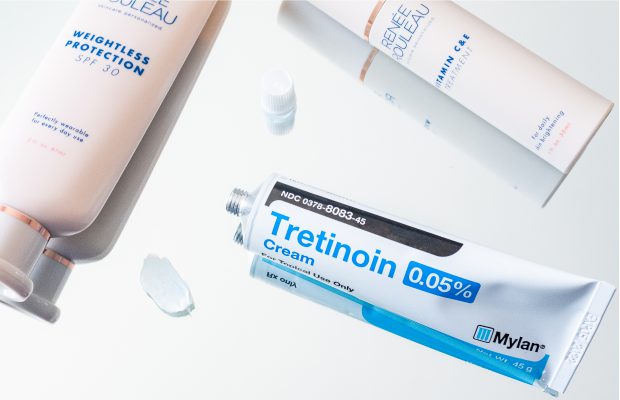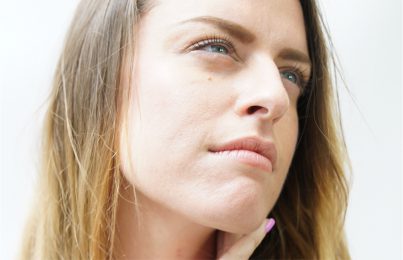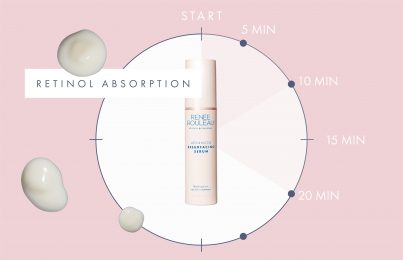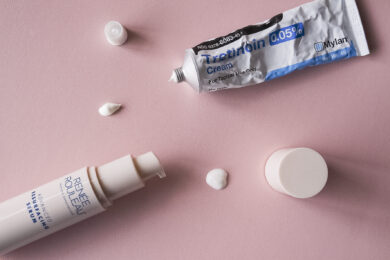Updated 05/22/22. When it comes to visibly improving the texture of your skin while preventing future signs of aging, prescription retinoids are unmatched. Trust me—after over 30 years of experience working as an esthetician, I’ve seen the dramatic improvements consistent retinoid use has made in my client’s skin, and my own!
- What Is a Prescription Retinoid, and Who Needs One?
- Why Should You Adjust Your Skincare Routine When Using a Prescription Retinoid?
- How Should You Adjust Your Skincare Routine When Using a Prescription Retinoid?
- What If I Adjust My Skincare Routine and I Still Struggle with Side Effects?
- The Bottom Line
Unfortunately, many people have a hard time using prescription retinoids consistently due to the side effects they can cause, such as dryness, irritation, flakiness, and peeling. Luckily, there are things you can do to mitigate these side effects. Keep reading for my expert tips on how to adjust your skincare routine to keep your skin comfortable while using a prescription retinoid!
What Is a Prescription Retinoid, and Who Needs One?
First up, a little refresher course! Retinoids are a class of ingredients derived from vitamin A that are great for targeting pigmentation, texture concerns, clogged pores, fine lines, and wrinkles. They also help build up collagen within the skin.
In order for your skin to use a retinoid, it has to convert it into retinoic acid. The reason prescription retinoids are so much stronger than non-prescription retinoids is that they’re already in the form of retinoic acid. In other words, they don’t require any conversions to get there and they’re completely bioavailable to your skin.
Read the different types of retinoids and how they affect the skin.
Who Should Use a Prescription Retinoid?
While they’re undoubtedly very effective, prescription retinoids are no joke and won’t be suitable for everyone. (You’ll want to talk to your dermatologist to see if you’re an ideal candidate.) In my experience, I believe they’re best suited for those who have one or more of the following:
- Post-breakout marks as well as indents from severe cystic acne
- Clogged pores (closed comedones)
- Enlarged pores
- Sun damage (pigmentation)
- Fine lines and wrinkles
If you’re in your mid to late twenties and are strictly looking for preventative aging benefits, I recommend using non-prescription retinol, like the Advanced Resurfacing Serum. Learn more about how to know whether you should be using a prescription retinoid or non-prescription retinol in my beginner’s guide to retinol and retinoids.
Why Should You Adjust Your Skincare Routine When Using a Prescription Retinoid?
So why does starting a prescription retinoid mean you need to reconsider the rest of your skincare routine?
Well, it’s important to remember that a prescription retinoid isn’t just another skincare product—it’s a medication prescribed by a doctor. It’s designed to have a drastic impact on how your skin behaves. While this is what makes it such an effective product, it can also mean unwanted side effects like dryness, flaking, and sensitivity for a lot of people (especially during the first four to six weeks).
The nature of a prescription retinoid is that it will compromise your skin’s moisture barrier and cause irritation. This makes it harder for your skin to hold onto moisture, which is the underlying catalyst for all those nasty side effects. Unfortunately, that’s just the way it is, and for some people, these side effects never completely go away. This is why it’s important to adjust your routine—you need to compensate and make sure it’s getting what it needs to keep the irritation to a minimum.
How Should You Adjust Your Skincare Routine When Using a Prescription Retinoid?
When incorporating a prescription retinoid into your routine, I believe it’s best to use it at night after cleansing and toning. How often you use your retinoid will depend on your skin type and specific needs. This is definitely something you should discuss with your prescribing doctor. With that said, most doctors will want you to work your way up to consistently using your prescription at least three nights a week (I personally never think people should use it more than five nights a week. Your skin requires a variety of active ingredients, not just one).
Even though how you use your retinoid is very personal, there are a few guidelines everyone can follow to make using a prescription retinoid more manageable. The goal should be to use gentle products that help your skin retain moisture. Here are my tips for adjusting your routine to accommodate the consistent (and successful) use of a prescription retinoid.
Cleanser
Use something gentle. You never want to use a cleanser that strips the skin of hydration, but this is even more important when your routine includes a prescription retinoid. Look for a cleanser that doesn’t contain any of these:
- Sulfates (these are used in foaming products to create a lather and will dry out the skin)
- Solvent alcohols (denatured or SD alcohol 40)
- A high percentage of fragrance
Instead, look for a cleanser that includes moisture-binding ingredients such as glycerin to support your skin’s barrier.
Toner
I think toners are essential and can be a great way to infuse hydration into the skin, but you have to make sure you’re using the right kind. First of all, make sure your toner is alcohol-free. Traditional astringent toners usually include drying alcohols that are sure to leave your skin feeling tight and cracked. This is the last thing you want! Secondly, don’t use a toner that contains exfoliating acids. While you still need to exfoliate if you use a prescription retinoid, applying acids to your skin every day in a toner form may be too much to handle.
Once you’ve applied your toner, wait for your skin to dry, then apply your retinoid.
Note: Normally I recommend applying serums to the skin while it’s still damp from toner, but with a prescription retinoid, it gets a little trickier. Skin is up to 10 times more permeable when damp and while this can sometimes work in your favor, it may also increase your chances of irritation when it comes to a retinoid.
Serum
As a general rule, I’m not a fan of using serums at the same time as prescription retinoids. You want your retinoid to be the star of the show, so it’s best to save your other serums for “off” nights when you’re not using it. Learn why I prefer using serums in rotation instead of mixing them together.
Moisturizer
Because prescription retinoids compromise your skin’s barrier and make it harder for you to retain moisture, I recommend that most people kick their moisturizer up a notch. This doesn’t mean everyone should switch to a super-rich cream, especially if they have breakout-prone skin. Just go up a level from what you were using before.
For example, if you were using a gel moisturizer, move up to a lotion. If you were using a lotion, move up to a light cream. You don’t want to overdo it, but using something a little thicker will help your skin hang on to moisture.
When you’re first starting out, you can apply your moisturizer right after applying your prescription retinoid to help mitigate some of the side effects. Then, slowly work your way up to leaving your prescription retinoid on the skin for up to 20 minutes before applying moisturizer. This will help you get the full effect.
Exfoliator
Whether you exfoliate more or less while on a prescription retinoid depends on what you were doing before, but gentle exfoliation is key for managing the surface dryness that accompanies retinoid use. Prescription retinoids work within the skin to increase the rate of cell turnover. This means that retinoids encourage skin cells to rise to the surface at a faster rate. Once these cells reach the surface (and the end of their life cycle), they dry out and need to be dissolved away. This is where exfoliation comes in.
I recommend using an alcohol-free exfoliating acid serum once or twice a week (not on the prescription retinoid night), depending on what your skin can handle. You may be able to handle more exfoliation the longer you use your retinoid.
Can I use an Exfoliating Peel if I Use a Prescription Retinoid?
I would stay away from this at the beginning, but once your skin has adjusted, you can use an at-home peel up to once a week. Just use it in place of your exfoliating serum one night. You may be able to use it some weeks and not others depending on a number of factors. The idea here is that your skin needs protective cells to help retain moisture in the skin and if you’re over-exfoliating combined with the use of a retinoid, your skin can experience more dryness. It’s important to listen to your skin.
If you’re getting a professional chemical peel, consult your provider. I know most estheticians will recommend you stop using a retinoid for a week before and after your peel.
Can I use a Facial Scrub if I Use a Prescription Retinoid?
This one surprises a lot of people, but I highly recommend gentle facial scrubs. While exfoliating acids dissolve the bonds that keep dead skin cells together, a facial scrub can actually lift them up and away. That’s why I recommend using a combination of chemical and physical exfoliants, even for prescription retinoid users. The combination will help manage dryness and increase the efficacy of the retinoid since it won’t have to penetrate through layers of dead skin. Just be sure you’re not using a facial scrub and an exfoliating acid on the same day. Again, we don’t want your skin to get too much exfoliation.
Sunscreen
This one is so important. Retinoids make your skin more sensitive to the sun, so if you’re using one (especially if it’s prescription-strength), you must wear sunscreen each and every day. Apply it generously and make sure you reapply often to protect your skin from damage. As I always say, sunscreen is the cornerstone of any good skincare routine, and that’s especially true with you’re using retinoids.
What If I Adjust My Skincare Routine and I Still Struggle with Side Effects?
Side effects may never totally subside for everyone, and at a certain point, skincare products can only do so much to prevent them. Some people will have to accept a certain level of surface dryness or sensitivity. This is more likely to occur if you have very fair skin since it tends to be thinner and more sensitive.
It’s normal for most people to experience side effects like irritation and flaking for the first four to six weeks. But if you’ve adjusted your routine and the side effects are still too much after this initial period, you might need to do a reset. Start by laying off your prescription for a week and let your skin recover. Then, in my experience, the best move is to start again very slowly. Use your prescription just once a week until you can tolerate it, and slowly move up from there. It’s also good to check with your doctor. They can help you make specific adjustments.
Pro tip: It takes about 48 hours for your skin to show dryness after coming into contact with a retinoid. For example, you could apply your prescription retinoid on a Monday night, have a little tightness the following day, then start experiencing dryness and flakiness on Wednesday. Keep this in mind and time your retinoid use for when you don’t have any special events coming up.
The Bottom Line
Remember, at the end of the day, you have to be patient and prepared for the side effects that come with a prescription retinoid skincare routine. The goal is to find what works best for you so that you can use your prescription retinoid consistently. I know it can be a lot of effort, but if you stick with it, I promise you’ll get a huge return on investment!
Next, find out how long it takes to see results when using retinol.
Celebrity Esthetician & Skincare Expert
As an esthetician trained in cosmetic chemistry, Renée Rouleau has spent 30 years researching skin, educating her audience, and building an award-winning line of products. Her hands-on experience as an esthetician and trusted skin care expert has created a real-world solution — products that are formulated for nine different types of skin so your face will get exactly what it needs to look and feel its best. Trusted by celebrities, editors, bloggers, and skincare obsessives around the globe, her vast real-world knowledge and constant research are why Marie Claire calls her “the most passionate skin practitioner we know.”



